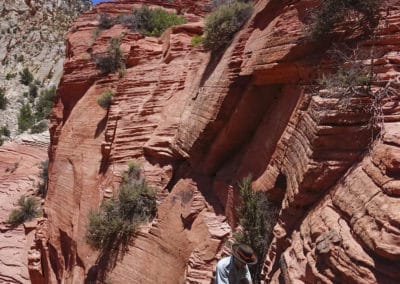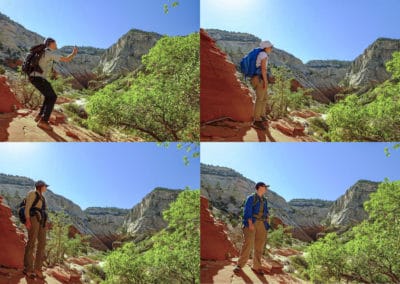Team Utah enjoying some shade during a break on the hill slopes.
Caroline, Charley, Curtis, and Madison have all been pushing hard to finish theses, classwork, and preparations for the upcoming GSA Cordilleran Section meeting in Portland, Oregon. They have tackled a range of questions involving the evolution of normal fault transfer zones, thinking about how fault segments propagate laterally and vertically through sedimentary strata, deforming the rock around them as fault segments interact.
Charley Hankla (College of Wooster) analyzed structural data from fractures within the transfer zone to put together a hypothesis of transfer zone evolution. Although most fractures across the transfer zone display orientations subparallel to the dominant fault segments, suggesting synchronous formation of faults and those fractures, Charley suggests that a major fault within the transfer zone grew northward over time, impacting the stress field around the fault, forming fractures that deviate from the dominant fracture orientation.
Caroline McKeighan (Trinity University) used a combination of fracture analysis based on 3D computer modeling of Unmanned Aerial Vehicle (UAV) video data and field-based structural data to develop a better picture of the distribution of fractures both horizontally and vertically across the transfer zone relative to a location where a single fault segment accommodates all extension. She found that where a single fault accommodates all extension, fracturing is intense but localized adjacent to the fault, but where several faults accommodate strain, in the transfer zone, fracturing is less intense but well-distributed within the rock between faults.
Curtis Segarra (Trinity University) used 2D geomechanical modeling to simulate the propagation of a normal fault through sedimentary strata. He found that the presence of layering allows for simultaneous, but discontinuous, plastic failure at multiple locations ahead of the propagating fault tip. Inter-layer stress accumulation is hindered by an increased number of layers, but regions of elevated stress occur further ahead of a propagating fault tip with more layers. His results indicate a predictable pattern of fracturing ahead of a propagating fault within layered strata.
Madison Woodley (Mt. Holyoke College) used a combination of field-based fracture orientation data and statistical cluster analysis to evaluate fracturing within the transfer zone relative to fracturing that occurred where only a single fault accommodates all extension. She found that fracturing at both localities have similar orientations, suggesting formation within the same stress field and at the same time. Madison also found that another fracture set in the transfer zone deviates from the dominant fracture set, which she hypothesizes has resulted in more strain accommodate where that set is present. Importantly, she documented significant clustering of fractures across the transfer zone, but at the single fault segment locality, fractures were more regularly spaced.
These results have implications for fracture network evolution and the nature of subsurface fluid flow in similar structural settings worldwide. We’re looking forward to presenting these data at Cordilleran Section GSA in Portland, Oregon, from May 14 – 17.
Watch the video of pre-field preparations.




